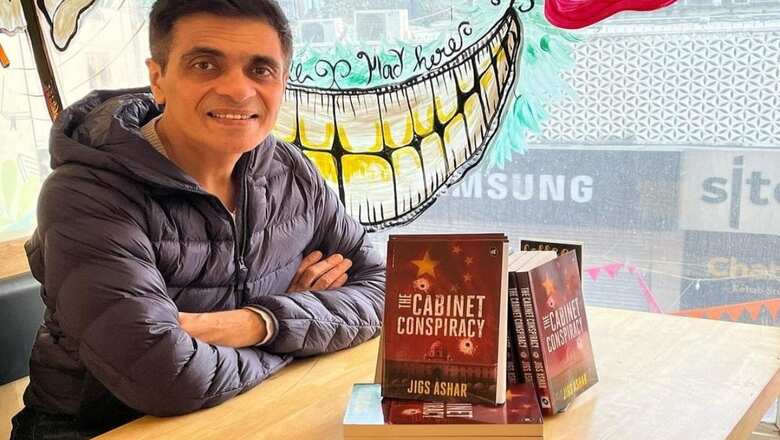
views
Renowned author Jigs Ashar has made a triumphant return with his latest thriller, ‘The Cabinet Conspiracy’ (Srishti), an international political espionage unfolding within the corridors of power in India. A few years back, the master storyteller Jeffrey Archer had declared Ashar a winner for the best short story. This exciting thriller guarantees to deliver the pace and twists reminiscent of Jeffrey Archer and Frederick Forsyth.
The narrative revolves around a plot involving an assassination attempt on the Prime Minister of India, blending reality with fiction through relatable characters and a captivating setting, making it a gripping and fast-paced read.
In an interview, Ashar spoke about the research involved in writing a political thriller and his approach to the genre and more…

Edited excerpts from the interview:
Could you provide some background on the inspiration behind the main character, Mahendra Doshi?
The inspiration for Doshi stemmed from my fascination with China’s Belt and Road Initiative. In 2018, during a work trip to Indonesia, I stumbled upon a special issue of The New York Times on the BRI. The sheer scale of China’s ambition fascinated me, especially as I learned of India’s refusal to participate. This sparked the question: How far would China go to make India sign? As I explored the clash between China and India, the character of Mahendra Doshi, the Indian Prime Minister, emerged. The narrative evolved into fiction, focusing on the Indian Prime Minister as the key decision-maker. The central plot explored removing Doshi to pave the way for a pro-China leader.
Over two years, I meticulously developed the storyline, blending real events with fiction, in what I term “faction.” The character of Doshi intentionally echoes real-world figures like Narendra Modi, drawing from their political backgrounds, including being the Chief Minister of Gujarat twice. Despite intentional parallels, none are portrayed negatively, ensuring accuracy in research and presenting a captivating narrative.
Since you incorporated geopolitical elements into your narrative, and particularly the Belt and Road Initiative, were there any challenges portraying real-world political tensions in a fictional story?
When presenting a well-researched book, featuring real elements with significant global impact, a key challenge arises – striking the right balance between delving into the intricacies of real situations and seamlessly reintegrating them into the fictional narrative. This challenge is especially pronounced when addressing topical events like the coastal road marathon or impending elections in India, coinciding with the book’s setting. What added a surreal twist was the alignment of the storyline, written years ago, with real-world developments like Mumbai’s trans-harbor link, poised for inauguration. The challenge then became skillfully blending these factual elements into the fictional scenes, all while maintaining the book’s pace and momentum.
The ‘chocolate bomb’ incident in the book is quite intriguing. What inspired you to incorporate such a creative and unconventional method of attack into your narrative?
I was on the hunt for a unique and innovative method for the assassin to carry out the killings in the story. That’s when I stumbled upon the concept of a chocolate bomb. It was quite unexpected—an article, again in The New York Times, detailed how the Nazis had devised a chocolate bomb with intentions to target Winston Churchill. The mission was, however, aborted at the last minute. Intrigued by this historical twist, I delved into understanding improvised explosive devices (IEDs), their mechanisms, and potential triggers.
Incorporating this newfound knowledge, I decided to weave it into the character of Ajit Raut—a chocolate enthusiast. Even in his introduction scene, where he’s discussing the marathon with the Sethna Group Chairman and Sanjay Adhikari, Ajit is engrossed in munching chocolates. The twist unfolds just as the chocolate bomb is about to be triggered. My aim was to inject an element of innovation and surprise, showcasing the unexpected ways in which chocolate could be utilised as a bomb.
How do you keep your thrillers exciting and fast-paced? Especially when you’re mixing real events and complex plot twists, how do you ensure the story stays engaging?
I consider myself a structured writer, and during my creative writing course, I learned about the scientific graph that good stories tend to follow. This structure involves highs, lows, and a climactic culmination, fitting into the classic three-act framework. When it comes to pacing, I start with the plot idea, jotting down details like the main characters, their backgrounds, and the interplay between them using the traditional pen-and-paper method in my diary.
Once I decide on the story’s starting point, I summarise each chapter in an Excel file with three or four lines. This allows me to assess the story’s progression and make adjustments if needed. Maintaining a cohesive timeline and ensuring no character is forgotten is crucial. Studying this Excel map gives me a clear understanding of the book’s pacing before I dive into writing the detailed chapters. For me, each story has a rhythm or ‘sur,’ and missing it can make the narrative ‘besura’ or off-key. To maintain this rhythm, I dedicate significant time to writing and rewriting until the narrative aligns with the envisioned pacing.
How have the main characters evolved throughout the story, especially considering the political and personal challenges they face? Can you elaborate on the character development arcs in the book?
If I were to delve into the evolution of Prime Minister Mahendra Doshi’s character throughout the story, it’s a journey marked by layers of complexity. Initially introduced as a popular leader poised for election victory, Doshi’s enigma deepens with his unexpected announcement not to contest, setting the stage for a mysterious narrative. As the plot progresses, Doshi emerges as a leader making strategic decisions, subtly hinting at an awareness of his mortality. His allegiance to the party and the nation is unwavering, evident in the scenes at Davos, where trust and camaraderie with his core team shine through.
The turning point comes when Doshi starts suspecting a traitor within his inner circle. The once-unquestionable loyalty of those around him now faces scrutiny, creating an intricate arc as he doubts even those closest to him. A notable moment unfolds when Doshi attempts to caution Adhikari, revealing a leader concerned for his team’s safety and strategically testing their responses.
In a compelling twist, Doshi falls victim to a deceptive ploy orchestrated by China. The revelation that he sees through the ruse showcases his political acumen and astuteness, highlighting a depth to his character beyond initial perceptions. A final act of nobility defines his character as he discreetly shares the serpent’s identity with Adhikari, preserving the party’s integrity. This act of selflessness underscores Doshi’s evolution, transforming from a charismatic leader to a figure of wisdom and sacrifice, leaving an indelible mark on the narrative.
Next is the serpent. The Serpent’s evolution unfolds as he transitions from a discreet figure within the prime minister’s cabinet to a cunning mastermind with diabolical ambitions. For an extended period, he remained concealed, deeply rooted in the corridors of power, consistently operating in the background. The pivotal moment came when the Serpent, driven by an insatiable lust for power, struck a covert deal with China. This calculated move was just one piece of a sinister puzzle that also involved him hiring an assassin. The Serpent’s transformation reveals a malevolent character adept at navigating the shadows and orchestrating complex manoeuvres to achieve his ruthless political goals.
Next is the assassin. As I crafted the character of the assassin M, I grappled with the decision of whether M should be male or female. Ultimately, I settled on a female character, believing it would add more intrigue to the persona I wanted to build. Right from the beginning, M’s sole motivation is money, a driving force that sets the tone for her actions throughout the story. What makes M particularly captivating is her mastery of disguise and proficiency in multiple languages, rendering her identity an ever-elusive mystery. I wanted to emphasise the lengths she goes to ensure each kill is flawless, deriving not just financial gain but also a sense of satisfaction and exhilaration. To M, being an assassin is akin to being a traveller, an opportunity to explore the world while carrying out her deadly pursuits. There’s a profound sadistic element in her character, evident in the enjoyment she derives from her actions.
Amidst her ruthless demeanour, I introduced a singular soft aspect—M’s underlying love for Andrey Lugovoy. Despite the complexities of his KGB affiliations, M longs for his attention, creating a nuanced layer to her character. In essence, M emerges as a calculated, cold-blooded, and ruthless killer, fueled by a singular motivation yet harbouring complex emotions beneath the surface.
Delving into the final character, Anant, the protagonist. Anant is not just physically fit; he’s also remarkably clever, having established an informal network of informants. This idea struck me when considering the vast number of Swiggy and Zomato delivery personnel visiting countless houses daily. I speculated that these individuals could unwittingly stumble upon sleeper cells or antisocial elements, especially in the realm of food deliveries. Understanding the limited staffing of the police force, I envisioned Anant leveraging these informants to fill the intelligence gap effectively.
Anant is portrayed as an entirely virtuous character without any shades of grey. His only internal struggle stems from the haunting demons of believing he played a role in the loss of his child. This remorse shapes his tender spot for children, reflecting his compassionate side. Despite this personal dilemma, Anant remains unwavering in his pursuit of justice.
The constant dilemma he faces surfaces in his relationship with Nandini. As she suffers, Anant grapples with the internal conflict of prioritising her well-being over his commitment to catching terrorists and antisocial elements. This showcases his vulnerability, revealing a layer of emotional complexity beneath his otherwise strong exterior. At times, Anant contemplates sacrificing his professional endeavours for the sake of his wife, demonstrating a poignant vulnerability in his character. Despite his internal battles and the relentless fight against personal demons, Anant emerges as a resilient and formidable force, embodying strength and determination in the face of adversity.
“The prime minister continues to be on his guard, not knowing when, and how, the Serpent will strike again.” Can we anticipate a sequel based on this open-ended conclusion?
I’d be thrilled to pen one. In my narrative, Adhikari, the Prime Minister, is in the know about the serpent’s identity, but he mysteriously vanishes without a trace. Even though the reader knows that the serpent has been killed, his body is not found. This leaves room for the potential of a sequel, where another character might step into the serpent’s role. If there’s a plot as compelling as this, writing a sequel would certainly be a captivating endeavour for me.
What’s next for you? Can you share any insights into your upcoming projects?
I have three books coming up. The first one, ‘The Headless Victim,’ is a true crime story set in Madras, India, around the Second World War. The case marked a pivotal moment as it was the first in India where forensics played a crucial role in solving a murder. It’ll be my initial release. Following that, I’m working on another true crime tale titled ‘The Assassination of Akku Yadav’. This story delves into the reign of terror caused by the dreaded gangster in Nagpur, Maharashtra, ultimately ending with his lynching in court by a group of women.
Lastly, I’ve recently been commissioned by Srishti for a book titled ‘The Boardroom Mafia’. Drawing from my 25-26 years of experience in banking, this book exposes the dark underbelly of the industry, exploring the nexus between banking, financial crime, and terrorism, and shedding light on the largest financial scam in India.
Views expressed in the above piece are personal and solely that of the author. They do not necessarily reflect News18’s views.



















Comments
0 comment